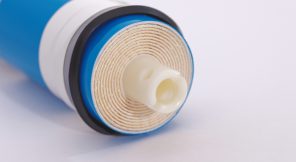Novel Process to Enhance the Membrane Performance in Forward Osmosis Systems
Novel process to enhance the membrane performance in forward osmosis systems

Forward osmosis is a process utilizing the osmotic pressure difference generated by a concentration difference as a driving force to get solvent from a less concentrated solution to a more concentrated solution through a semi-permeable membrane. Compared with reverse osmosis, forward osmosis requires little energy input because the process is a one-stage process relying upon solutions. The process allows high water recovery, enabling the use of the process in seawater desalination and wastewater treatment. Forward osmosis has become more important in recent years due to the global water scarcity problem and due to most seawater desalination and wastewater treatment plants relying on energy-intensive hydraulic pressure driven processes. Due to the increased focus on the forward osmosis processes, there is a market need for methods and technologies to enhance the processes.
Technology Summary
A limitation in forward osmosis is the low water flux that occurs due to the internal concentration polarization of the membranes in the process. Researchers at KAUST have developed a process that could be used to alleviate the internal concentration polarization and enhance the membrane performance by applying a small pressure on the feed side. The most relevant application for the described process is in water desalination; however the process could also be used in wastewater processing and fruit juice filtering/concentrating.
How It Works
The unique process is comprised of passing a fluid in a forward osmosis system from a feed solution (unpurified solvent) with a low osmotic pressure through a membrane into a draw solution that is comprised of a draw solute with a higher osmotic pressure. The membrane includes an active layer facing the draw side and a support layer facing the feed side. The process is achieved by applying an external force to the feed side of the system, which acts as an incremental force to the osmotic pressure gradient driving force. A commercial system developed from the process could be embodied by equipment, including software, controllers, sensors, and actuation devices that can be retrofitted to any forward osmosis system to apply and control the pressure on the feed side of the filtration process.
Why It Is Better
The process developed has a number of advantages when compared to existing reverse osmosis processes. The process reduces the internal concentration polarization in membranes, thereby reducing the propensity for fouling and reverse solute diffusion. The process also increases the osmotic driving force between the system feed and draw sides. Commercially available thin-film composite membranes for reverse osmosis and nanofiltration membranes can be used for the development process, limiting the necessity of specialized membranes. In addition, the process results in a tenfold increase in the water flux, and decreases the salt passage for thin-film composite membranes. Furthermore, the process may result in reduced forward osmosis system operating costs and improved freshwater yields.
IP Protection
KAUST has several patents pending for this technology.
Invention Track Code
2012-033

Benefits
- Unlike reverse osmosis processes, the developed process requires less energy and results in less fouling and reverse solute diffusion
-
Utilizes commercial thin-film composite reverse osmosis membranes and nanofiltration membranes
-
Increases the water flux by ten times and decreases the salt passage for thin-film composite membranes

Applications
- Water desalination
- Wastewater treatment
- Fruit juice filtration/concentration
